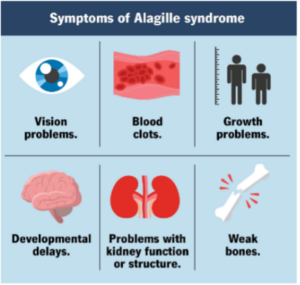Alagille syndrome
Liver Illness
At a glance
- Alagille syndrome (ALGS) can be an inherited or an acquired gene mutation
- It is a multi-system disease with symptoms including jaundice, pruritis, skeletal abnormalities and kidney disease
- It is rare, affecting one in 70,000 infants, approximately
- Click here to read Claragh’s story with ALGS
What is it?
Bile aids in the removal of waste from the body and it also breaks down fats and fat-soluble vitamins. Bile ducts are the tubes or channels through which bile flows from the liver and gall bladder to the small intestine, where it can consequently leave the body as a waste. Alagille  syndrome is both an acquired and inherited disease in which there are too few bile ducts in the liver and bile builds up to concentrations where liver damage occurs. This damage eventually might lead to liver failure. Due to liver damage and malabsorption of fats and vitamins, other parts of the body can be affected, including kidneys, skeletal system and circulatory system.
syndrome is both an acquired and inherited disease in which there are too few bile ducts in the liver and bile builds up to concentrations where liver damage occurs. This damage eventually might lead to liver failure. Due to liver damage and malabsorption of fats and vitamins, other parts of the body can be affected, including kidneys, skeletal system and circulatory system.
When Alagille syndrome (ALGS) is an inherited disease, it is present at birth, though typical symptoms might not be observed in the first two years of life. It can also occur as a consequence of an acquired gene mutation which might mean it is not detected until later.
 Typical symptoms
Typical symptoms
Symptoms include typical liver disease indicators including jaundice, itchiness or pruritis and dark urine. Other symptoms might include reduced kidney size and function, decreased efficiency, blood vessel irregularities and heart murmurs. Symptoms vary among people with the disease and other symptoms might include blood clots, enlarged spleen (splenomegaly), skeletal abnormalities, vision problems and distinctive facial features.
Incidence
ALGS is estimated to affect one in 30,000 to one in 100, 000 individuals, with an average of one in 70,000 infants diagnosed. However, this figure may be an underestimation, as liver disease does not always present in newborns or infants.
Diagnosis
ALGS is described as a multi-system disease and diagnosis is therefore made by several techniques including liver biopsy, genetic testing, spine X-ray, kidney function tests and abdominal ultrasound. The diagnosis of ALGS is confirmed when the Alagille syndrome triad is found. This is when an abnormal liver biopsy (demonstrating fewer than normal bile ducts) and three of the following signs – unusual bone or spine structures, heart murmur or abnormal blood vessel structure, typical ALGS facial characteristics and a characteristic white ring on the cornea – must be present.
Treatment
Individuals affected by ALGS receive multidisciplinary treatment from a team of specialists, not least hepatologists, nephrologists, haematologists, orthopedists and dermatologists. There is no cure as yet for ALGS, so treatments are dependent on the symptoms experienced. This might include medications to increase bile flow from the liver, skincare or medicine to reduce itching, vitamins, food supplements and sometimes surgery to redirect bile. Liver transplant is also a consideration in the case of severe liver damage and / or liver failure.
Prognosis
Treatments for ALGS can prevent or minimise complications and improve quality of life. It is therefore very important that an individual with this disease works closely with a medical team to increase bile flow and treat symptoms, such as itching, related to bile accumulation. Instructions for diet or lifestyle changes to improve health and comfort should be followed and as treatments might change over time, so it is important to work closely with a healthcare provider.